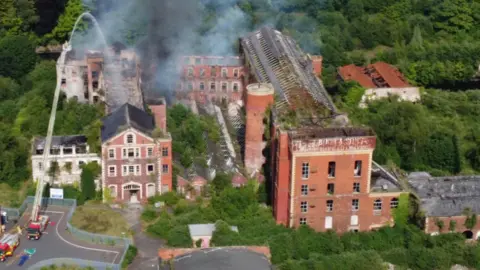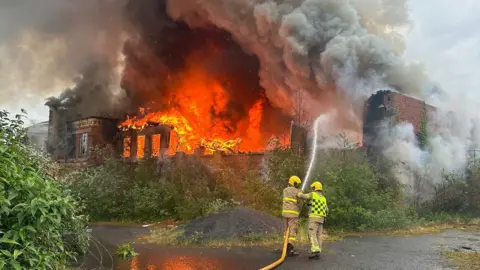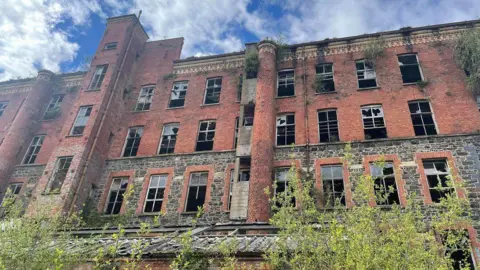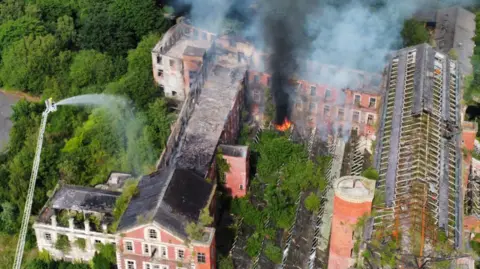Permission sought to demolish most of listed mill
 NIFRS
NIFRSA developer has applied for permission to demolish most of the listed buildings at Hilden Mill near Lisburn.
A consultant for PJK Developments told BBC News NI that it would not be financially viable to redevelop the site without the demolition.
An application for listed building consent has been submitted to Lisburn and Castlereagh City Council.
The mill has been listed since 1989, and a number of redevelopment projects have been proposed since it closed in 2006.
However, none of these have been advanced, and the buildings have been repeatedly vandalised and set on fire, most recently in May this year.
The developers are now seeking permission to demolish all but two of the remaining structures at the site.
They are hoping that the remaining two buildings could be retained and redeveloped for community use.
In respect of the mill structures they have applied to demolish, the consultant told BBC News NI they have received reports from various engineers and surveyors and “the buildings have been shown to be completely and utterly uneconomic to restore".
He added: “The intention is that if we obtain the consent to knock the buildings down, we will then make a positive planning application to redevelop the site for residential purposes, a significant part of which is likely to be for social housing."
 Robbie Butler
Robbie ButlerUlster Architectural Heritage (UAH) said the organisation is concerned by the application and the buildings have been at "considerable risk for decades under several different ownerships".
The society said Hilden Mill has been "allowed to deteriorate to what local councillors across NI, typically and conveniently dismiss as just an ’eyesore’".
"This represents just the latest example of the failure of the Northern Ireland Executive and the responsible arms of departments, local government, and law enforcement, to safeguard the built and industrial heritage asset of the Northern Ireland economy," the UAH added.
In reference to previous UAH judicial reviews, the society said long term neglect is not a material planning consideration when it comes to listed buildings.
Independent councillor Gary Hynds said Hilden Mill is of important historical significance to the Lisburn area.
“At least part of the history must be kept,” he said.
“I would never support knocking the whole thing down.”
Mr Hynds said he had been in contact with the developers to urge them to preserve some of the buildings for community use.
He cited the example of Hilden School, which is currently being redeveloped to house a tearoom, nursery, and heritage displays.
The councillor explained he was not opposed to the partial redevelopment of the mill complex for residential use, but he would want more detail on the type of homes being proposed.
“I support the idea of co-ownership that gives the people of the area more chance of getting on the housing ladder,” he said.
History of Hilden Mill
 PSNI
PSNIHilden Mill is a 24-acre former factory site on the edge of Lisburn city, overlooking the River Lagan.
The site had been used as a linen bleaching green until it was taken over by the industrialist William Barbour in 1823.
Barbour's father had emigrated from Scotland about 40 years earlier and set up a linen thread business at a nearby site in Lisburn.
William Barbour built a water-powered mill at Hilden, setting the foundations for a firm that would become one of the largest linen thread manufacturers in the world.
The Barbours employed many thousands of people at Hilden over the decades, and they built a model village for their workforce.
This included hundreds of homes, two schools, a community hall, a village sports ground, and a children's playground.
In the 1990s, Hilden Mill amalgamated with the international firm Coats Ltd and became known as the Coats Barbour factory, producing specialist thread for the automotive and upholstery industries.
But by 2006, its market had declined, and the thread factory site closed with the loss of 85 jobs.
 NIFRS
NIFRSSince then, various owners have attempted to redevelop the mill but have not succeeded.
A previous plan to build more than 600 homes on the site was granted planning permission in 2009.
However, the construction did not proceed, and that planning permission has since lapsed.
In recent years, the site has been repeatedly targeted by vandals and arsonists.
In 2011, 60 firefighters tackled a major fire which badly damaged the top three floors of the mill.
A decade later, arsonists targeted the mill twice in the space of two months, the first of which destroyed a section of its roof.
The most recent blaze in May 2024 caused extensive damage to some of the remaining structures.
It required more than 40 firefighters and an aerial appliance to bring the flames under control.
The Police Service of Northern Ireland (PSNI) confirmed at the time that fire was also being treated as deliberate.
